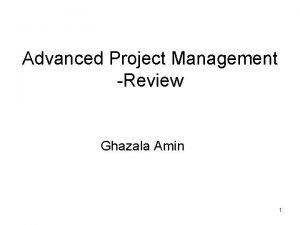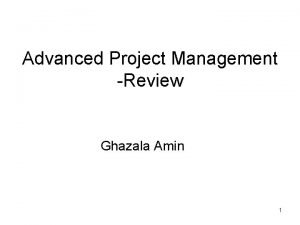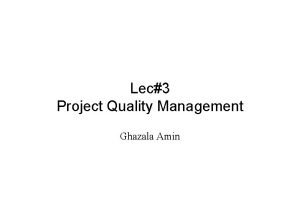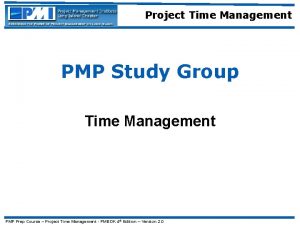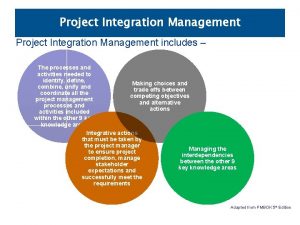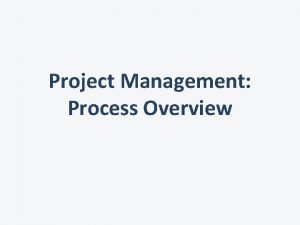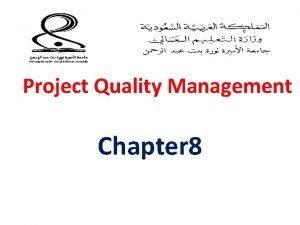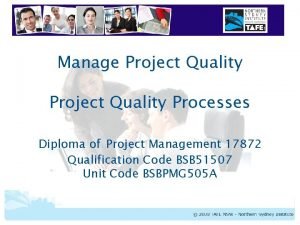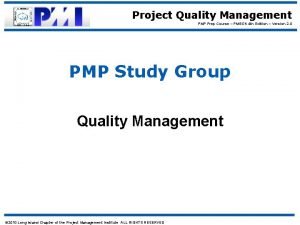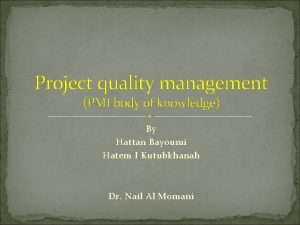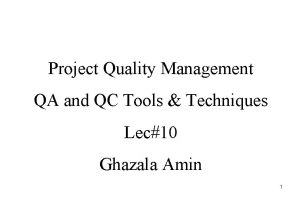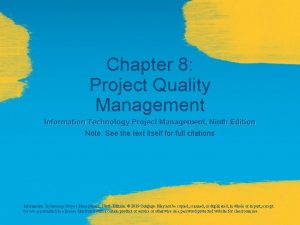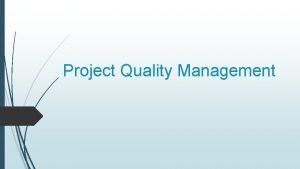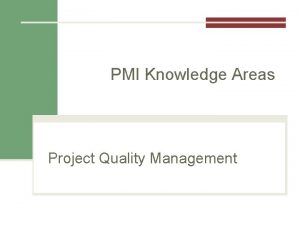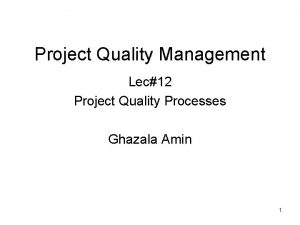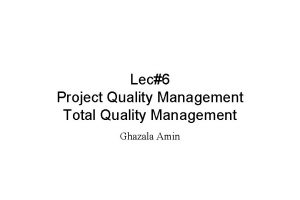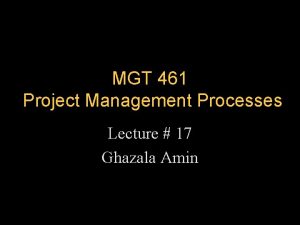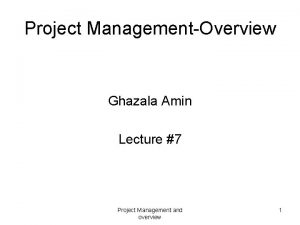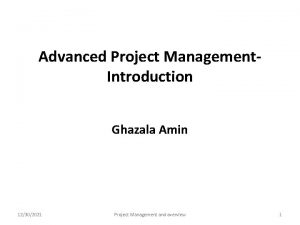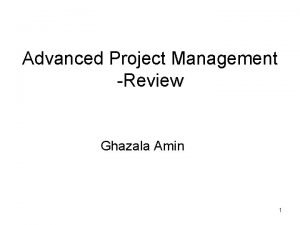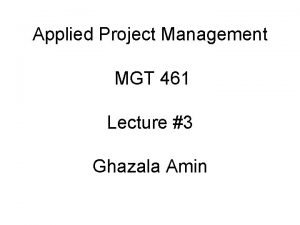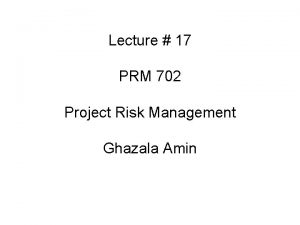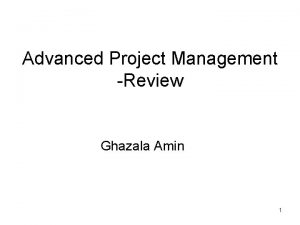Project Quality Management Lec12 Project Quality Processes Ghazala




























- Slides: 28

Project Quality Management Lec#12 Project Quality Processes Ghazala Amin 1

Quality Processes • Process is a logical organization of people, material, equipment and procedures into work activities designed to produce a specified end result. – From Pall, Gabriel A. Quality Process Management 2

Quality Processes • The quality of a system is highly influenced by the quality of the process used to acquire, develop and maintain it. • This statement focuses on processes as well as the product. – Established strongly in manufacturing industries. – Quality movement visible in not only manufacturing but now common in service industries e. g. ISO standards, CMMI etc. – It is now widely implemented and enforced in IT development. 3

Quality Nodes Schedule Requirements People Quality Cost Process Technology • Process-People-Technology triad for product development. – Process, people and technology are the major determinants of any product’s cost, schedule, and quality. 4

Quality Nodes Schedule Requirements People Quality Cost Process Technology It is important to have motivated, quality work force but even our finest people cannot perform at their best when process is not understood or is not operating at its best. 5

When Quality process is immature • Ad hoc processes are improvised by practitioners and their management. • Processes are not followed or enforced • Performance is dependent on a particular practitioner • Understanding the current status of project is limited. Heroes are accidental but not professional practitioners What about your surgeon? ? 6

When Quality process is immature • Immature processes result in fighting fires – No time to improve – Constantly in reactive mode rather than proactive – Firefighters get burned easily !!!! – Embers may rekindle later. A professional is a man who can do his best at a time when he doesn’t particularly feel like it”. - Alistair Cooke 7

When Quality process is mature • Process descriptions are consistent with the way work actually gets done. • They are defined, documented and continuously improved. • Processes are supported visibly by management. • Well controlled processes are enforced and evaluated • Constructive use of process measurement • Technology is introduced in a disciplined manner. 8

When Quality processes is implemented • “That’s the way we do things around here”. • Organization contains effective, usable and consistently applied processes. • Management nurtures the culture. • Culture is conveyed through role model and recognition. • Processes stay well after the originators (people who defined the processes) are gone. Mature processes = Fire Prevention 9

Benefits of mature Project Quality processes • Process improvements are made not processes from scratch. • Causes less stress for human resources when they move to different projects and work with different project managers. • Project status for sponsors and teams are predictable. • Project control techniques are predictable. • Technology, tools and techniques can be introduced systematically. • Project resources have more chance to develop their potential and focus on professional growth and training. 10

Probability of success Benefits of predicting Project performance a. Process is measured and controlled a. b. Process is institutionalized for projects but is sometimes reactive. b. c. Process is poorly controlled, reactive and unpredictable. c. Time/Rs. $/… 11

Early Process Improvement • The theories of quality process management are synthesis of concepts of Deming, Crosby, Juran and others. • Over the past decades, these theories have been used to address problems common to many organizations. • Solutions to some problems have been addressed many still remain, some hidden and some untold!! • Many of these solutions have been used to build process improvement models. 12

Improving Project Quality • Several suggestions for improving quality for projects include: – Establish leadership that promotes quality. – Understand the cost of quality. – Focus on organizational influences and workplace factors that affect quality. – Follow maturity models. 13

Organizational Influences 14

Expectations and Cultural Differences in Quality • Project managers must understand manage stakeholder expectations. • Expectations also vary by: – Organization’s culture – Geographic regions 15

Organizational Influences, Workplace Factors, and Quality • Study by De. Marco and Lister showed that organizational issues had a much greater influence on programmer productivity than the technical environment or programming languages. • Programmer productivity varied by a factor of one to ten across organizations, but only by 21 percent within the same organization. • Study found no correlation between productivity and programming language, years of experience, or salary. • A dedicated workspace and a quiet work environment were key factors to improving programmer productivity. 16

Quality Process and Maturity Model 17

What is a Quality Process Model? • A process model is a structured collection of practices that describe the characteristics of effective processes. • Practices that are included in a process model have been proven by experience to be effective. 18

How is a Quality Process Model used? • A process model is used – To help set process improvement objectives and priorities of the organization – Helps ensure capable and mature processes – Guide for improving upon existing processes – Use an appraisal method to diagnose state of an organizational current practices. 19

Why is a Quality Process Model important? • A process model provides – A place to start improving – Common language and shared vision – Template for prioritizing actions – Benefit of prior experiences – What improvement means for the organization 20

Maturity Models • Maturity models are frameworks for helping organizations improve their processes and systems. – The Software Quality Function Deployment Model focuses on defining user requirements and planning software projects. – The Software Engineering Institute’s Capability Maturity Model is a five-level model laying out a generic path to process improvement for software development in organizations. 21

CMMI-Capability Maturity Model • Capability Maturity Model Integration (CMMI) • is a process improvement approach that provides organizations with the essential elements of effective processes that ultimately improve their performance. • CMMI can be used to guide process improvement across a project, a division, or an entire organization • CMMI according to the SEI (Software Engineering Institute), helps "integrate traditionally separate organizational functions, set process improvement goals and priorities, provide guidance for quality processes, and provide a point of reference for appraising current processes. 22

CMMI-Capability Maturity Model • Levels are used in CMMI to describe the path for an organization that wants to improve the processes it uses to develop and maintain its products and services. • CMMI supports two improvement approaches; • Continuous-enabling an organization to incrementally improve processes within a process area selected by the organization. • Staged – enabling the organization to improve a set of related processes by addressing successive predefined sets of process areas. 23

CMMI-Capability Maturity Model 24

PMI’s Maturity Model • PMI released the Organizational Project Management Maturity Model (OPM 3) in December 2003. • Model is based on market research surveys sent to more than 30, 000 project management professionals and incorporates 180 best practices and more than 2, 400 capabilities, outcomes, and key performance indicators. • Addresses standards for excellence in project, program, and portfolio management best practices and explains the capabilities necessary to achieve those best practices. 25

Project Management Maturity Model 26 Reference: Dr. Harold Kerzner’s PROJECT MANAGEMENT A SYSTEMS APPROACH TO PLANNING, SCHEDULING, AND CONTROLLING Page 929: Project Management Maturity Model

Continuous Improvement 27 Reference: Dr. Harold Kerzner’s PROJECT MANAGEMENT A SYSTEMS APPROACH TO PLANNING, SCHEDULING, AND CONTROLLING Page 941: Continuous Improvement

Bottom Line Process improvement should be done to help the business – not for its own sake. “In God we trust, all others bring data. ” -W. Edwards Deming 28
 Ghazala amin
Ghazala amin Ghazala amin
Ghazala amin Ghazala amin
Ghazala amin Quality management assignment
Quality management assignment Concurrent processes are processes that
Concurrent processes are processes that Project time management processes
Project time management processes Integration management in project management
Integration management in project management Six processes of project integration management
Six processes of project integration management A process consists of one or more
A process consists of one or more Importance of software project management
Importance of software project management Pmbok quality assurance vs quality control
Pmbok quality assurance vs quality control Project quality management definition
Project quality management definition What are quality standards in project management
What are quality standards in project management Project management lecture notes doc
Project management lecture notes doc Project quality management pmp
Project quality management pmp Control chart precision accuracy pmp
Control chart precision accuracy pmp Quality control tools and techniques
Quality control tools and techniques Quality management pmp
Quality management pmp Information technology project management 8th edition
Information technology project management 8th edition Project management quality control
Project management quality control Project management quality tools
Project management quality tools Importance of project quality management
Importance of project quality management Quality management in operations management
Quality management in operations management Contemporary management theory ppt
Contemporary management theory ppt What is tqm
What is tqm Wharton risk center
Wharton risk center Event management in itil
Event management in itil Cost management processes pmbok
Cost management processes pmbok The role of project management in achieving project success
The role of project management in achieving project success
